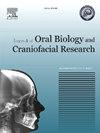Zebrafish caudal fin model to investigate the role of Cissus quadrangularis, bioceramics, and tendon extracellular matrix scaffolds in bone regeneration
Q1 Medicine
Journal of oral biology and craniofacial research
Pub Date : 2025-06-07
DOI:10.1016/j.jobcr.2025.05.009
引用次数: 0
Abstract
Introduction
Periodontal bone regeneration faces several challenges such as incomplete bone-ligament-cementum restoration, unpredictable clinical outcomes and membrane exposure risks. The zebra fish caudal fin model of regeneration could be an excellent model system for mimicking the periodontal regenerative criteria and the present study aimed to explore the potential of innovative composite scaffolds characterized by C. quadrangularis, carrageenan, and tendon ECM with silver hydroxyapatite and silver tricalcium phosphate for periodontal bone regeneration by using the zebrafishes as model organisms.
Materials and methods
Zebrafish were subjected to caudal fin amputation, followed by the application of different scaffold groups. The fabricated scaffolds were then crosslinked using glutaraldehyde vapours and stored in a desiccator for future use. The scaffolds were classified into five groups: negative control, PERIO COL- GTR (G1), Cissus quadrangularis extract, carrageenan, tendon extracellular matrix (TEM) (Group 2), Group 3 (contained silver hydroxyapatite + Group 2 components), Group 4 (Silver tricalcium phosphate + Group 2 components). Scaffolds characterization was done using FTIR and UV–Vis Spectroscopy. Regeneration was evaluated using microscopically and histologically.
Results
The physical characterization showed the scaffold interaction by spectral differentiation between the groups. Among the groups, Test group 4 demonstrated superior regeneration with enhanced collagen deposition, reduced inflammatory response, and significantly higher growth compared to control.
Conclusion
These findings suggested that group 4 scaffold significantly accelerates zebrafish fin regeneration, making these scaffolds promising candidates for periodontal tissue engineering and regenerative medicine applications.
建立斑马鱼尾鳍模型,探讨四角棘、生物陶瓷和肌腱细胞外基质支架在骨再生中的作用
牙周骨再生面临着一些挑战,如骨-韧带-骨质修复不完整、临床结果不可预测和膜暴露风险。斑马鱼尾鳍再生模型是一个很好的模拟牙周再生标准的模型系统,本研究旨在以斑马鱼为模型生物,探索以斑马鱼为模型生物,以斑马鱼尾鳍、角叉胶、羟基磷灰石银和磷酸三钙银为复合材料的新型支架用于牙周骨再生的潜力。材料与方法对斑马鱼进行尾鳍切除,然后应用不同的支架组。然后用戊二醛蒸汽将合成的支架交联,并储存在干燥器中以备将来使用。支架分为5组:阴性对照、PERIO COL- GTR (G1)、四角星提取物、卡拉胶、肌腱细胞外基质(TEM)(2组)、3组(含羟基磷灰石银+ 2组成分)、4组(磷酸三钙银+ 2组成分)。利用FTIR和UV-Vis光谱对支架进行表征。用显微镜和组织学方法评估再生情况。结果两组间的光谱分化显示了支架相互作用。与对照组相比,试验4组表现出较好的再生能力,胶原沉积增强,炎症反应减轻,生长明显加快。结论4组支架可显著促进斑马鱼鱼鳍的再生,具有良好的牙周组织工程和再生医学应用前景。
本文章由计算机程序翻译,如有差异,请以英文原文为准。
求助全文
约1分钟内获得全文
求助全文
来源期刊

Journal of oral biology and craniofacial research
Medicine-Otorhinolaryngology
CiteScore
4.90
自引率
0.00%
发文量
133
审稿时长
167 days
期刊介绍:
Journal of Oral Biology and Craniofacial Research (JOBCR)is the official journal of the Craniofacial Research Foundation (CRF). The journal aims to provide a common platform for both clinical and translational research and to promote interdisciplinary sciences in craniofacial region. JOBCR publishes content that includes diseases, injuries and defects in the head, neck, face, jaws and the hard and soft tissues of the mouth and jaws and face region; diagnosis and medical management of diseases specific to the orofacial tissues and of oral manifestations of systemic diseases; studies on identifying populations at risk of oral disease or in need of specific care, and comparing regional, environmental, social, and access similarities and differences in dental care between populations; diseases of the mouth and related structures like salivary glands, temporomandibular joints, facial muscles and perioral skin; biomedical engineering, tissue engineering and stem cells. The journal publishes reviews, commentaries, peer-reviewed original research articles, short communication, and case reports.
 求助内容:
求助内容: 应助结果提醒方式:
应助结果提醒方式:


